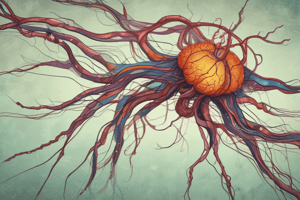Podcast
Questions and Answers
What is the primary effect of Beta-1 selective antagonists like metoprolol?
What is the primary effect of Beta-1 selective antagonists like metoprolol?
- Constricting blood vessels
- Increasing heart rate
- Inducing bronchoconstriction
- Decreasing heart rate (correct)
Which type of adrenergic agonist primarily influences the muscles around the bronchioles?
Which type of adrenergic agonist primarily influences the muscles around the bronchioles?
- Beta-2 agonists (correct)
- Alpha-agonists
- Beta-1 selective antagonists
- Beta-1 agonists
What is the main effect of alpha-agonists on blood vessels?
What is the main effect of alpha-agonists on blood vessels?
- Bronchodilation
- Vasodilation
- Vasoconstriction (correct)
- Increase heart rate
How do beta-2 agonist medications impact the body?
How do beta-2 agonist medications impact the body?
Which adrenergic receptor class primarily influences cardiovascular function?
Which adrenergic receptor class primarily influences cardiovascular function?
What effect do beta-receptors have on myocardial contraction?
What effect do beta-receptors have on myocardial contraction?
Which neurotransmitters are involved in the adrenergic system?
Which neurotransmitters are involved in the adrenergic system?
What is the role of adrenergic antagonists?
What is the role of adrenergic antagonists?
Which type of adrenergic antagonist primarily targets receptors outside the central nervous system?
Which type of adrenergic antagonist primarily targets receptors outside the central nervous system?
What is the main function of beta-blockers in the body?
What is the main function of beta-blockers in the body?
How do adrenergic antagonists affect the response to stress?
How do adrenergic antagonists affect the response to stress?
Which medication is commonly used to treat high blood pressure and urinary symptoms by blocking alpha receptors?
Which medication is commonly used to treat high blood pressure and urinary symptoms by blocking alpha receptors?
Study Notes
Understanding the Adrenergic System
The adrenergic system is part of our body's complex neural network, involving signaling molecules called neurotransmitters known as catecholamines—dopamine, norepinephrine, and epinephrine. This system plays a crucial role in regulating various aspects of physiology such as heart rate, blood pressure, respiration, metabolism, and stress response. To better appreciate its functions, let's delve into the roles played by adrenergic antagonists, agonists, and receptors within this system.
Adrenergic Antagonists
Adrenergic antagonists block the effects of norepinephrine and epinephrine released from nerve cells or glands like the adrenal medulla. These drugs bind to specific sites on adrenergic receptors, preventing activation by their natural ligands. There are two main types of adrenergic antagonists based upon which receptor they target:
- Alpha-blockers: Block alpha receptors found primarily outside the central nervous system; examples include prazosin and doxazosin used to treat high blood pressure, urinary symptoms of benign prostatic hypertrophy, and Raynaud’s phenomenon.
- Beta-blockers: Inhibit beta receptors throughout the body – particularly inside the heart and lungs; these medications can slow down heartbeat, decrease blood pressure, and reduce anxiety during acute attacks; common examples include propranolol, atenolol, and bisoprolol. Some beta-blockers only affect certain subtypes:
- Beta-1 selective antagonists like metoprolol act mainly on cardiac tissue, reducing heart rate while maintaining normal bronchodilation.
- Beta-2 selective antagonists have minimal effect on the heart, making them safer options for patients with asthma or chronic obstructive pulmonary disease (COPD) since they won't exacerbate breathing difficulties.
Adrenergic Agonists
Conversely, adrenergic agonists work by activating and strengthening the action of adrenergic receptors when stimulated by endogenous catecholamines. They may also mimic the actions of adrenaline and noradrenaline directly:
- Alpha-agonists boost blood vessel constriction and cause smooth muscle relaxation, thereby decreasing bladder tone. Examples include oxymetazoline nasal spray and tizanidine (muscle relaxant).
- Beta-agonist medications increase heart rate, dilate airways, enhance contractions of the uterus, and raise blood glucose levels depending upon the type of receptor targeted:
- Beta-1 agonists principally influence the heart, increasing heart rate and contractility. For example, dopamine infusions and dobutamine intravenously administered for heart failure treatment.
- Beta-2 agonists predominantly impact muscles around the bronchioles. Salbutamol and terbutaline are examples often prescribed to people suffering from asthma or COPD for symptom relief.
Adrenergic Receptors
There exist three major classes of adrenergic receptors: alpha-1 (alpha-1), alpha-2 (alpha-2), and beta-1 (beta-1), beta-2 (beta-2):
- Alpha-receptors primarily influence vascular smooth muscle contraction, causing vasoconstriction, and modulate release of other neurotransmitters.
- Beta-receptors govern cardiovascular function, lipolysis, and glycogenolysis. Activation of beta-receptors increases heart rate and force of myocardial contraction, causes vasodilation, and promotes breakdown of fats and sugars stored in liver and skeletal muscle cells.
Understanding how antagonists, agonists, and receptors interact provides valuable insights into the adrenergic system's functions and helps explain why specific pharmaceuticals play essential therapeutic roles in managing numerous conditions.
Studying That Suits You
Use AI to generate personalized quizzes and flashcards to suit your learning preferences.
Description
Test your knowledge on the adrenergic system and its crucial role in regulating heart rate, blood pressure, metabolism, and stress response. Explore the functions of adrenergic antagonists, agonists, and receptors in managing various physiological conditions.




